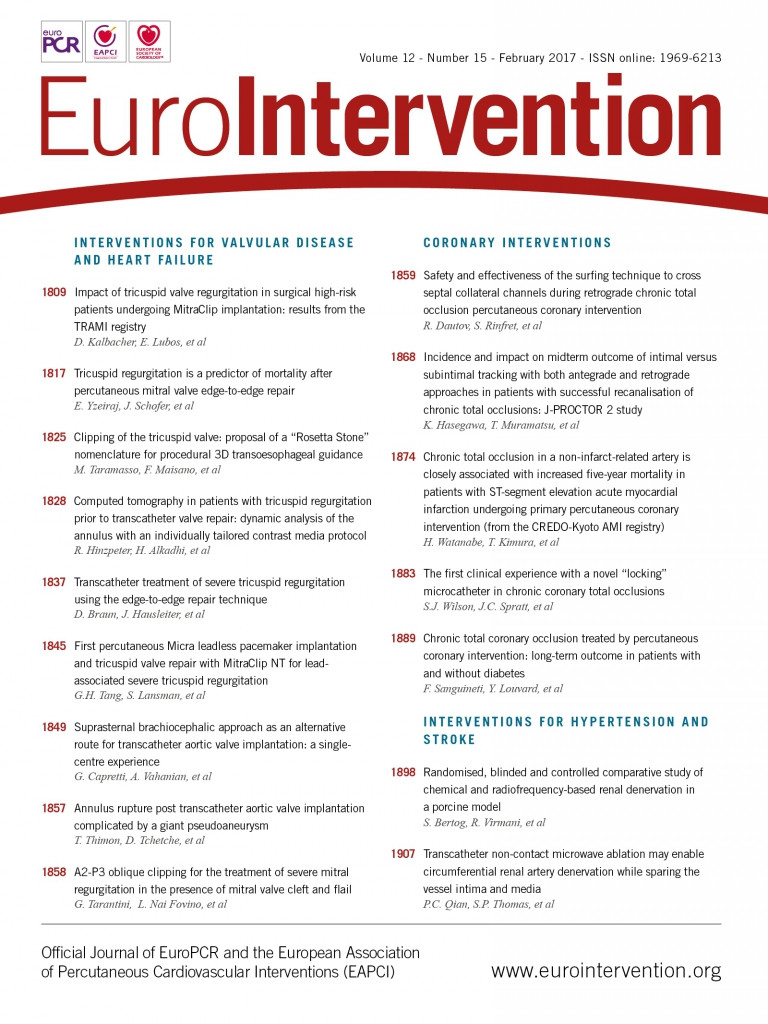
Recent developments in the emerging field of transcatheter therapies for tricuspid regurgitation (TR) have stimulated renewed interest in the “forgotten” tricuspid valve. In this edition of EuroIntervention, the impact of residual TR following transcatheter mitral intervention, MitraClip® (Abbott Vascular, Santa Clara, CA, USA) deployment for severe TR, and novel imaging protocols of the tricuspid valve are presented.
Tricuspid regurgitation may be attributable to a primary valve lesion or, more commonly in the presence of a morphologically normal valve, due to annular dilatation and/or leaflet tethering due to right ventricular pressure and/or volume overload (functional). While trivial TR is frequently encountered in normal subjects, increasing severity of TR has been associated with substantial morbidity and mortality: up to one third of patients with severe TR die within one year of diagnosis1.
The long-held belief that functional TR improves following successful left-sided surgery has recently been challenged2,3, as half of all patients with untreated TR develop progressive valve dysfunction despite successful left-sided surgery, and this portends a poor prognosis4. Hence, the European guidelines recommend tricuspid repair during left-heart surgery in the presence of severe TR (class I; level of evidence C), moderate primary TR (IIa; C), and ≥mild TR with annular dilatation (≥40 mm) (IIa; C)5. Surgical repair is also recommended in symptomatic patients with severe primary TR (I; C) or in asymptomatic patients with progressive RV dilatation (IIa; C). Scant data underpin these recommendations, as is evident by the level of evidence (all C), which probably contributes to considerable undertreatment of functional TR.
In an analysis of the German Transcatheter Mitral Valve Interventions (TRAMI) registry (N=766), Kalbacher et al assessed the impact of pre-existing TR on clinical outcomes6. In this large prospective registry, these investigators confirmed previous reports of higher one-year mortality with increasing TR grade among MitraClip recipients7,8. Patients with severe TR had elevated rates of atrial fibrillation, pulmonary hypertension, and residual mitral regurgitation; however, severe TR was associated with impaired survival on multivariable analysis (hazard ratio [HR]: 2.0). In a separate report by Yzeiraj et al, the Hamburg group led by Joachim Schofer also found severe baseline TR to be independently associated with impaired survival (HR: 4.4) following MitraClip implantation9. Going a step further, these authors report an improvement in TR (≥1 grade) in nearly half of all patients with baseline moderate/severe TR after successful mitral clipping. Prior studies have observed improvement in TR grade following MitraClip implantation in 33-69%7,8. Importantly, medium-term mortality was lower among those who manifested reduced TR compared to those who did not (11.4% vs. 40.5%). It remains unknown, however, if the TR reduction after mitral clipping is sustained in the longer term. Indeed, surgical series have suggested that the observed early reduction in TR following mitral surgery is temporary, and can evolve to progressive dyspnoea and poor survival10.
In March 2016, Hammerstingl and colleagues first described the adaptation of the MitraClip system for the treatment of TR11. Using a similar technique, Braun and colleagues report 18 cases of MitraClip implantation on the tricuspid valve (MiTriClip) in patients with moderate/severe TR and right heart failure12. Among these high-risk (EuroSCORE II: 10±8%) functional TR patients, six (33%) had isolated TR, while 12 (66%) underwent concomitant mitral valve clipping during the index intervention. An average of 2.3±0.7 clips were deployed on the tricuspid valve per patient, most commonly between the anterior and septal leaflets. A reduction in TR of ≥1 grade and improvement in NYHA class was achieved in 89% of cases, without procedural MACCE. The authors are to be congratulated for sharing their early experience and for the impressive echocardiographic and clinical outcomes achieved. The reduction in TR grade with MiTriClip appears roughly similar to that reported for a variety of alternative transcatheter tricuspid repair devices. In the absence of prospective safety and efficacy data for MiTriClip, however, one could question the decision to proceed with simultaneous mitral and tricuspid clipping. Given the aforementioned early improvement in TR following mitral intervention, staging the tricuspid clipping seems to be a reasonable alternative. On the other hand, practical and cost concerns, and the likelihood of TR progression make simultaneous clipping attractive. In these pages, Tang et al elegantly illustrate the complexity of transcatheter management of severe mitral and tricuspid regurgitation in a high-risk patient: coronary stenting; mitral clipping; septal closure; replacement of a transvenous pacemaker with a leadless device; and finally MiTriClip13. Is this a preview of multivalve disease management in the future?
The final manuscript on the tricuspid theme by Hinzpeter et al describes a novel patient-centric computed tomography protocol for imaging the tricuspid valve14. Consistent with prior analyses15, Hinzpeter et al observe increasing tricuspid annular dimensions with increasing grades of TR, and a potentially important increase in annular area (approximately 10%) in ventricular diastole. Such detailed anatomical and spatial imaging analysis is crucial to the planning and execution of transcatheter therapies for TR.
Each of us has cared for patients with severe TR and right heart failure. We have witnessed at first hand the distressing impact this often overlooked and undertreated pathology has on both the quality and the quantity of our patients’ lives. In the absence of a friendly (or rogue) surgeon, we have “managed” TR by ratcheting up the dose of diuretic until the inevitable kidney failure and unrelenting oedema prevail. In this context, the renewed focus on the treatment of tricuspid regurgitation is very welcome indeed. The forgotten valve no more.

